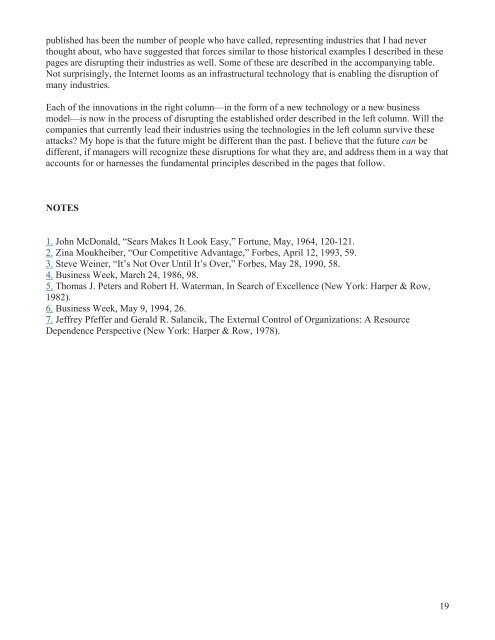- Page 2 and 3: TheInnovator’sDilemmaWhen New Tec
- Page 4 and 5: ContentsIn GratitudeIntroductionPAR
- Page 6 and 7: Clayton M. ChristensenHarvard Busin
- Page 8 and 9: Digital Equipment Corporation creat
- Page 10 and 11: they lose their positions of leader
- Page 12 and 13: Disruptive Technologies versus Rati
- Page 14 and 15: understand what has caused those ci
- Page 16 and 17: Chapter 7 discusses a different app
- Page 20 and 21: Part OneWHY GREAT COMPANIESCAN FAIL
- Page 22 and 23: was the size of a large refrigerato
- Page 24 and 25: To test this hypothesis, I assemble
- Page 26 and 27: Figure 1.5 describes a sustaining t
- Page 28 and 29: Source: Data are from various issue
- Page 30 and 31: Between 1978 and 1980, several entr
- Page 32 and 33: The 3.5-inch drive was first develo
- Page 34 and 35: Figure 1.8 Leadership of Entrant Fi
- Page 36 and 37: Rigid Disk Drive Industry: A Histor
- Page 38 and 39: CHAPTER TWOValue Networks and theIm
- Page 40 and 41: toward sustaining innovations and a
- Page 42 and 43: how each value network exhibits a v
- Page 44 and 45: structure. Research, engineering, a
- Page 46 and 47: Figure 2.5 The Conventional Technol
- Page 48 and 49: firms’ decision-making processes
- Page 50 and 51: annually introduced as a percentage
- Page 52 and 53: ecause they have no moving parts, t
- Page 54 and 55: Figure 2.7 Improvements in Areal De
- Page 56 and 57: IMPLICATIONS OF THE VALUE NETWORK F
- Page 58 and 59: esident in companies today result f
- Page 60 and 61: CHAPTER THREEDisruptive Technologic
- Page 62 and 63: Source: Data are from the Historica
- Page 64 and 65: Because their capacity was so small
- Page 66 and 67: was thus a hybrid of the two techno
- Page 68 and 69:
Source: Data are from the Historica
- Page 70 and 71:
its archives, and Toth and Haddock
- Page 72 and 73:
CHAPTER FOURWhat Goes Up, Can’t G
- Page 74 and 75:
challenges of their competitors. Gr
- Page 76 and 77:
organization’s middle managers pl
- Page 78 and 79:
Managers in disk drive companies we
- Page 80 and 81:
Minimill steel making first became
- Page 82 and 83:
Once their position in the market f
- Page 84 and 85:
Indiana, in 1989, and constructed a
- Page 86 and 87:
Part TwoMANAGING DISRUPTIVETECHNOLO
- Page 88 and 89:
The sum of these studies is that wh
- Page 90 and 91:
want? One option is to convince eve
- Page 92 and 93:
engineering workstations, and has a
- Page 94 and 95:
those laws, people flew quite succe
- Page 96 and 97:
The first discount store was Korvet
- Page 98 and 99:
expansion in the regular variety st
- Page 100 and 101:
laser jet division is headed, will
- Page 102 and 103:
CHAPTER SIXMatch the Size of theOrg
- Page 104 and 105:
What benefit, if any, did leadershi
- Page 106 and 107:
Source: Data are from various issue
- Page 108 and 109:
Finally, there is substantial evide
- Page 110 and 111:
Because emerging markets are small
- Page 112 and 113:
There are many success stories to t
- Page 114 and 115:
This recommendation is not new, of
- Page 116 and 117:
13. “Can 3.5" Drives Displace 5.2
- Page 118 and 119:
data, Disk/Trend Report, published
- Page 120 and 121:
MB, and a second model, introduced
- Page 122 and 123:
to make small deliveries to local c
- Page 124 and 125:
Japanese semiconductor manufacturer
- Page 126 and 127:
powerful deterrent to the movement
- Page 128 and 129:
therefore, may view creation of new
- Page 130 and 131:
ResourcesResources are the most vis
- Page 132 and 133:
its Corona model—a product target
- Page 134 and 135:
go public based upon a hot initial
- Page 136 and 137:
such success in the minicomputer bu
- Page 138 and 139:
they made these acquisitions late a
- Page 140 and 141:
Figure 8.1 Fitting an Innovation’
- Page 142 and 143:
structured. For Compaq, Hewlett-Pac
- Page 144 and 145:
CHAPTER NINEPerformance Provided,Ma
- Page 146 and 147:
Specifically, in the desktop person
- Page 148 and 149:
A product becomes a commodity withi
- Page 150 and 151:
1. The Weaknesses of Disruptive Tec
- Page 152 and 153:
Scott Cook, Intuit’s founder, sur
- Page 154 and 155:
CONTROLLING THE EVOLUTION OF PRODUC
- Page 156 and 157:
Source: An earlier version of this
- Page 158 and 159:
originally developed by Venetian me
- Page 160 and 161:
The first step in making this chart
- Page 162 and 163:
Having decided that electric vehicl
- Page 164 and 165:
its braking distance longer than ot
- Page 166 and 167:
The major automakers engaged in ele
- Page 168 and 169:
customers who pay the present bills
- Page 170 and 171:
Clearly, as will be discussed below
- Page 172 and 173:
CHAPTER ELEVENThe Dilemmas of Innov
- Page 174 and 175:
Seventh, and last, the research sum
- Page 176 and 177:
develop those technologies themselv
- Page 178 and 179:
2. There is a tendency in all marke


